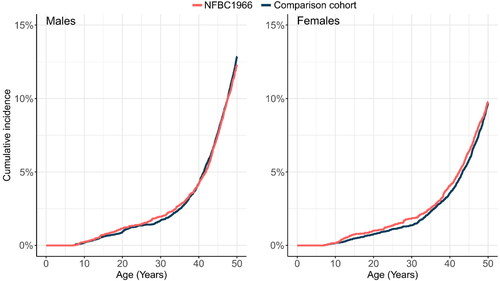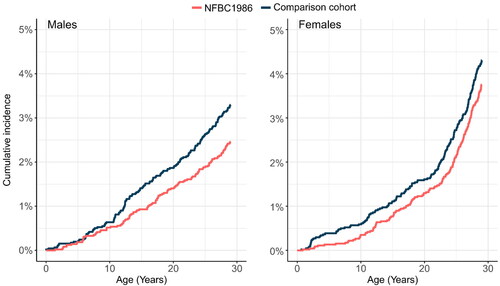Figures & data
Table 1. List of cardiometabolic disorders and their ICD-codes.
Figure 1. Cumulative incidence of first cardiometabolic disorders in NFBC1966 and comparison cohort at age 7 to 50 years by sex.

Table 2. Cardiovascular disorders in NFBC1966 with a comparison cohort at age 7 to 50 years.
Table 3. Age of onset (Median (IQR)) and difference in medians (Quantile estimation Q) with a p-value of cardiometabolic disorders in NFBC1966 and the comparison cohort at age 7 to 50 by sex.
Table 4. Diabetes mellitus from age 22 to 50 years in NFBC1966 and comparison cohort by sex.
Figure 2. Cumulative incidence of first cardiometabolic disorders in NFBC1986 and comparison cohort at age of 0 to 29 years by sex.

Table 5. Cardiovascular disorders in NFBC1986 with a comparison cohort at age 0 to 29 years.
Table 6. Age of onset (Median (IQR)) and difference in medians (Quantile estimation Q) with a p-value of cardiometabolic disorders in NFBC1986 and comparison cohort at age 0 to 29 by sex.
Table 7. Cumulative incidence % (N) of cardiometabolic-related deaths, and age of death caused by any cardiometabolic disorder at age 0 to 50 years in NFBC1966 with comparison cohort by sex.
Supplemental Material
Download MS Word (68.8 KB)Data availability statement
Data cannot be shared publicly because the utilised data have been given for this specific study, and the data cannot be shared without permission from the University of Oulu and Findata. The register data can be applied from Findata, the Finnish Health and Social Data Permit Authority by researchers who meet the criteria for access to confidential data. NFBC data is available from the University of Oulu, Infrastructure for Population Studies. Permission to use the data can be applied for research purposes via the electronic material request portal. In the use of data, we follow the EU general data protection regulation (679/2016) and Finnish Data Protection Act. The use of personal data is based on cohort participants written informed consent in his/her latest follow-up study, which may cause limitations to its use. Please, contact the NFBC project centre (NFBCprojectcenter(at)oulu.fi) and visit the cohort website for more information. Aggregated data underlying the results presented in the study can be asked from the corresponding author as long as the current permission is valid (2025).
